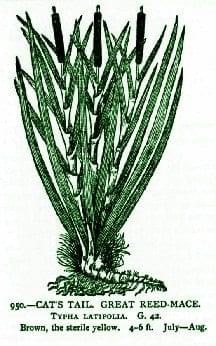Typha angustifolia – Typhaceae family
To Native Americans, cattail was a cornucopia. It provided food, medicine and clothing to any one inventive enough to utilize its resources. All cattail asked in return was a marshy place to grow and a little wind to spread its protein-rich pollen.
The jelly that grows between young leaves was used for wounds, boils and infected flesh. This treatment also relieved pain. This honey-looking product has strong antiseptic properties, which made cattail an indispensable part of the first aid kit on the American frontier for centuries. People living along cattail’s marshy shores still rely on it for treating everything from toothaches to spider bites.
To the practitioner of Traditional Chinese Medicine (TCM), cattail pollen is the prize of the marsh. Cattail pollen capsules, known as Pu Huang, are a popular remedy for nosebleeds, uterine bleeding and blood in the urine. TCM uses cattail pollen mixed with honey as a poultice for wounds. Chinese researchers are investigating cattail pollen’s reputation for shrinking cancerous tumors. Since this is powerful medicine, it should not to be used during pregnancy.
Recently, a civil engineer discovered that cattail is good medicine for the planet as well. After a thorough round of experiments, which involved measuring tubs of poisoned water, he found significant results. The cattail growing in the tubs were absorbing the arsenic from the water. In six weeks, existing arsenic levels were reduced as much as 89 percent. This means that developing countries with arsenic poisoned water can look forward to access to drinkable, life-giving water again within a few, short months. Now the rest of the world will have a chance to honor cattail’s cornucopia of benefits.







